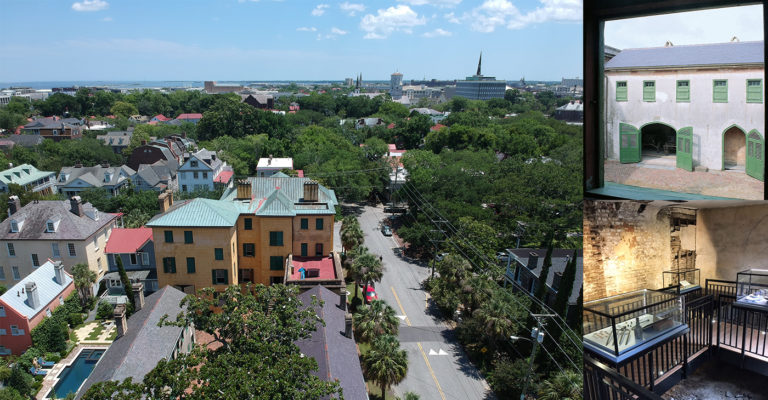Contact us at (843) 724-7305

Prints in Clay Walking Tour

- This event has passed.
Prints in Clay Walking Tour
September 15, 2018 @ 1:00 pm - 2:30 pm UTC+0
$40
“Beyond the Big House” to Private, Historic Buildings Where Enslaved People Lived and Worked
Presented by The Slave Dwelling Project, Historic Charleston Foundation and the Charleston Gaillard Center Look
(Limited tickets available. This is a walking tour.)
Step inside the back buildings and former work lots of Charleston’s private houses during the second annual Beyond the Big House Tour, Sept. 15, 2018, presented by The Slave Dwelling Project, the Charleston Gaillard Center and Historic Charleston Foundation (HCF). Kitchens, carriage houses, slave dwellings and even churches where the enslaved worshiped have survived to tell the stories of African Americans in early Charleston, their lives and immense contributions to the fabric of our city.
The Charleston Gaillard Center, where the tour will begin, stands between two historically significant early neighborhoods, Mazyck-Wraggborough and Ansonborough, separated by Calhoun Street. Now in the heart of Downtown, the earlier name for the thoroughfare, Boundary Street, represents a time when the road defined the northern edge of Charleston. Beyond the city limits in Mazyck-Wraggborough, where there were fewer restrictions on free people of color, a diverse community grew adjacent to the suburban villas of wealthy white planters and merchants. Explore several properties associated with African Americans, both free and enslaved, in these noteworthy neighborhoods and learn how the properties have been preserved and re-used by the current owners.
“When the buildings remain on the landscape, it’s hard to deny the presence of the people who lived in them,” said Joseph McGill, founder of The Slave Dwelling Project. “From these buildings, we learn about the lives of the enslaved people who inhabited or spent time in them. This event is part of a continuing effort to honor the enslaved ancestors. The history of the people who occupied these spaces should be intertwined with the stories of those who enslaved them. What started as an idea of English Purcell became a successful and enlightening sold-out event last year, one that moved many people. It continues to flourish as an opportunity for participants to explore and learn the history beyond the big house.”
English Purcell, a local researcher and administrator for the popular Facebook group “Charleston History before 1945,” said the idea came to her while “zooming across the Charleston peninsula” on Google Earth. “The number of smaller buildings behind the large dwellings on the lots was astounding,” she said. “We are very grateful to the property owners who live in these special spaces and have cared for them and preserved them. The lives of the enslaved were so unbelievably different from those who occupied the ‘big houses’ that are visible from the street. Charleston was the wealthiest city in colonial North America, and that wealth was built literally and figuratively by the enslaved. We want to highlight their stories. Focusing this tour on the buildings where the enslaved worked and lived is not only interesting historically, it is critical to telling the complete story of Charleston.”
In addition to private sites rarely open to the public, Historic Charleston Foundation’s Aiken-Rhett House lot and outbuildings, c.1820, which have been preserved as found, are included on the tour. The property survives as one of the best-preserved collections of 19th-century domestic buildings in the nation, and the expansive back lot includes slave quarters above the kitchen, laundry and carriage buildings.
“We are honored to be a part of this significant and meaningful educational program,” said Winslow W. Hastie, President & CEO of HCF. “Recent archaeological excavations in the laundry building at the Aiken-Rhett House yielded an unprecedented number of artifacts related to the daily lives of enslaved people on the property, discoveries that will allow us to continue to expand our interpretation of African American history at our house museums even further.”
Important Information for Tour Day:
Please present your ticket at the Charleston Gaillard Center Ticket Office on the day of the tour, Sept. 15, from 12:30-1:30 p.m., to receive your tour program and map. You may visit the tour properties listed in the program from 1-4 p.m., Sept. 15.
Begin your tour promptly at 1 p.m. to ensure that you may comfortably visit all of the sites on tour.
Children will be welcomed on the tour if tickets have been purchased for them.
The private, historic sites on tour are unable to accommodate wheelchairs.
This walking tour will cover several city blocks, sometimes over uneven sidewalks. Comfortable flat-soled shoes will make your walk easier and protect the floors of historic properties.
Guests are encouraged to bring bottled water with them on tour, particularly if the weather is warm. Guests may bring closed water bottles into the sites on tour.
No photography, please, at the private properties on tour, including both indoor and outdoor spaces.
